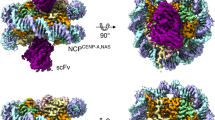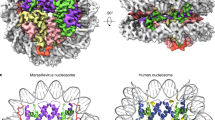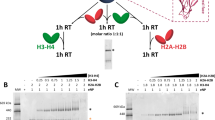Abstract
The X-ray crystal structure of the nucleosome core particle of chromatin shows in atomic detail how the histone protein octamer is assembled and how 146 base pairs of DNA are organized into a superhelix around it. Both histone/histone and histone/DNA interactions depend on the histone fold domains and additional, well ordered structure elements extending from this motif. Histone amino-terminal tails pass over and between the gyres of the DNA superhelix to contact neighbouring particles. The lack of uniformity between multiple histone/DNA-binding sites causes the DNA to deviate from ideal superhelix geometry.
This is a preview of subscription content, access via your institution
Access options
Subscribe to this journal
Receive 51 print issues and online access
$199.00 per year
only $3.90 per issue
Buy this article
- Purchase on Springer Link
- Instant access to full article PDF
Prices may be subject to local taxes which are calculated during checkout




Similar content being viewed by others
References
Kornberg, R. D. Structure of chromatin. Annu. Rev. Biochem. 46, 931–954 (1977).
McGhee, J. D. & Felsenfeld, G. Nucleosome structure. Annu. Rev. Biochem. 49, 1115–1156 (1980).
Widom, J. Toward a unified model of chromatin folding. Annu. Rev. Biophys. Biophys. Chem. 18, 365–395 (1989).
van Holde, K. E. Chromatin(Springer, New York, (1988).
Blank, T. A. & Becker, P. B. The effect of nucleosome phasing sequences and DNA topology on nucleosome spacing. J. Mol. Biol. 260, 1–8 (1996).
Wallrath, L. L., Lu, Q., Granok, H. & Elgin, S. C. R. Architectural variations of inducible eukaryotic promoters: Preset and remodeling chromatin structures. BioEssays 16, 165–170 (1994).
Flaus, A., Luger, K., Tan, S. & Richmond, T. J. Mapping nucleosome position at single base-pair resolution by using site-directed hydroxyl radicals. Proc. Natl Acad. Sci. USA 93, 1370–1375 (1996).
Travers, A. A. DNA bending and nucleosome positioning. Trends Biochem. Sci. 12, 108–112 (1987).
Flaus, A. & Richmond, T. J. Positioning and stability of nucleosomes on MMTV 3′ LTR sequences. J. Mol. Biol.(in the press).
Wasylyk, B. & Chambon, P. Transcription by eukaryotic RNA polymerases A and B of chromatin assembled in vitro. Eur. J. Biochem. 98, 317–327 (1979).
Grunstein, M. Histone function in transcription. Annu. Rev. Cell Biol. 6, 643–678 (1990).
Paranjape, S. M., Kamakaka, R. T. & Kadonaga, J. T. Role of chromatin structure in the regulation of transcription by RNA polymerase II. Annu. Rev. Biochem. 63, 265–297 (1994).
Polach, K. J. & Widom, J. Amodel for the cooperative binding of eukaryotic regulatory proteins to nucleosomal target sites. J. Mol. Biol. 258, 800–812 (1996).
Felsenfeld, G. Chromatin unfolds. Cell 86, 13–19 (1996).
Schild, C., Claret, F. X., Wahli, W. & Wolffe, A. P. Anucleosome-dependent static loop potentiates estrogen-regulated transcription from the Xenopus vitellogenin-B1 promoter in vitro. EMBO J. 12, 423–433 (1993).
Truss, M.et al. Hormone induces binding of receptors and transcription factors to a rearranged nucleosome on the MMTV promoter in vivo. EMBO J. 14, 1737–1751 (1995).
Rhodes, D., Brown, R. S. & Klug, A. Meth. Enzymol. 420–428 (Academic, San Diego, (1989).
Richmond, T. J., Finch, J. T., Rushton, B., Rhodes, D. & Klug, A. Structure of the nucleosome core particle at 7 Å resolution. Nature 311, 532–537 (1984).
Finch, J. T. et al. X-ray and electron microscope studies on the nucleosome structure. FEBS Lett. 51, 193–197 (1979).
Arents, G., Burlingame, R. W., Wang, B.-C., Love, W. E. & Moudrianakis, E. N. The nucleosomal core histone octamer at 3.1 Å resolution: A tripartite protein assembly and a left-handed superhelix. Proc. Natl Acad. Sci. USA 88, 10148–10152 (1991).
Richmond, T. J., Rechsteiner, T. & Luger, K. Studies of nucleosome structure. Cold Spring Harbor Symp. Quant. Biol. LVIII, 265–272 (1993).
Richmond, T. J., Searles, M. A. & Simpson, R. T. Crystals of a nucleosome core particle containing defined sequence DNA. J. Mol. Biol. 199, 161–170 (1988).
Luger, K., Rechsteiner, T. J., Flaus, A., Waye, M. M. Y. & Richmond, T. J. Characterization of nucleosome core particles containing histone proteins made in bacteria. J. Mol. Biol.(in the press).
Camerini-Otero, R. D. & Felsenfeld, G. Sulfhydryl modificaiton of nucleosome. Proc. Natl Acad. Sci. USA 74, 5519–5523 (1977).
Harp, J. M. et al. X-ray diffraction analysis of crystals containing twofold symmetric nucleosome core particles. Acta Crystallogr. D 52, 283–288 (1996).
Satchwell, S. C., Drew, H. R. & Travers, A. A. Sequence periodicities in chicken nucleosome core DNA. J. Mol. Biol. 191, 659–675 (1986).
Rhodes, D. & Klug, A. Sequence-dependent helical periodicity of DNA. Nature 292, 378–380 (1981).
Dickerson, R. E., Goodsell, D. S. & Neidle, S. “⃛ The tyranny of the lattice⃛”. Proc. Natl Acad. Sci. USA 91, 3579–3583 (1994).
Travers, A. A. & Klug, A. in DNA Topology and its Biological Effects(eds Cozzarelli, N. R.&Wang, J. C.) 57–106 (Cold Spring Harbor Press, Cold Spring Harbor, New York, (1990).
Pryciak, P. M. & Varmus, H. E. Nucleosomes, DNA-binding proteins, and DNA sequence modulate retroviral integration target site selection. Cell 69, 769–780 (1992).
Pruss, D., Bushmann, F. D. & Wolffe, A. P. Human immunodeficiency virus integrase directs integration to sites of severe DNA distortion within the nucleosome core. Proc. Natl Acad. Sci. USA 91, 5913–5917 (1994).
Polach, K. J. & Widom, J. Mechanism of protein access to specific DNA sequences in chromatin: a dynamic equilibrium model for gene regulation. J. Mol. Biol. 254, 130–149 (1995).
Studitsky, V. M., Clark, D. J. & Felsenfeld, G. Overcoming a nucleosomal barrier to transcription. Cell 83, 19–27 (1995).
Hirschhorn, J. N., Brown, S. A., Clark, C. D. & Winston, F. Evidence that SNF2/SWI2 and SNF5 activate transcription in yeast by altering chromatin structure. Genes Dev. 6, 2288–2298 (1992).
Kruger, W. et al. Amino acid substitutions in the structured domains of histones H3 and H4 partially relieve the requirement of the yeast SWI/SNF complex for transcription. Genes Dev. 9, 2770–2779 (1995).
Finch, J. T. & Klug, A. Solenoidal model for superstructure in chromatin. Proc. Natl Acad. Sci. USA 73, 1897–1901 (1976).
Thoma, F., Koller, T. & Klug, A. Involvement of histone H1 in the organization of the nucleosome and of the salt-dependent superstructures of chromatin. J. Cell Biol. 83, 403–427 (1979).
Widom, J. & Klug, A. Structure of the 300 Å chromatin filament: X-ray diffraction from oriented samples. Cell 43, 207–213 (1985).
Graziano, V., Gerchman, S. E., Schneider, D. K. & Ramakrishnan, V. Histone H1 is located in the interior of the chromatin 30-nm filament. Nature 368, 351–354 (1994).
Hecht, A., Laroche, T., Strahl-Bolsinger, S., Gasser, S. M. & Grunstein, M. Histone H3 and H4 N-termini interact with SIR3 and SIR4 proteins: A molecular model for the formation of heterochromatin in yeast. Cell 80, 583–592 (1995).
Starich, M. R., Sandman, K., Reeve, J. N. & Summers, M. F. NMR structure of HMfB from the hyperthermophile, Methanothermus fervidus, confirms that this archaeal protein is a histone. J. Mol. Biol. 255, 187–203 (1996).
Xie, X. et al. Structural similarity between TAFs and the heterotetrameric core of the histone octamer. Nature 380, 316–322 (1996).
Yang, T. P., Hansen, S. K., Oishi, K. K., Ryder, O. A. & Hamkalo, B. A. Characterization of a cloned repetitive DNA sequence concentrated on the human X chromosome. Proc. Natl Acad. Sci. USA 79, 6593–6597 (1982).
O'Halloran, T. V., Lippard, S. J., Richmond, T. J. & Klug, A. Multiple heavy-atom reagents for macromolecular X-ray structure determination. Application to the nucleosome core particle. J. Mol. Biol. 194, 705–712 (1987).
Jones, T. A., Zou, J. Y., Cowan, S. W. & Kjeldgaard, M. Improved methods for building protein models in electron density maps and the location of errors in these models. Acta Crystallogr. A 47, 110–119 (1991).
Brünger, A. X-PLOR v3.1 Manual(Yale Univ. Press, New Haven, (1992).
Ferrin, T. E., Huang, C. C., Jarvis, L. E. & Langridge, R. The MIDAS display system. J. Mol. Graph. 6, 13–27 (1988).
Nicholls, A., Sharp, K. & Honig, B. Protein folding and association: insights from the interfacial and thermodynamic properties of hydrocarbons. Proteins 11, 281–296 (1991).
Read, R. J. Improved Fourier coefficients for maps using phases from partial structures with errors. Acta Crystallogr. A 42, 140–149 (1986).
Böhm, L. & Crane-Robinson, C. Proteases as structural probes for chromatin: the domain structure of histones. Biosci. Rep. 4, 365–386 (1984).
Goldknopf, I. L. & Busch, H. Isopeptide linkage between nonhistone and histone 2A polypeptides of chromosomal conjugated-protein A24. Proc. Natl Acad. Sci. USA 74, 864–868 (1977).
Acknowledgements
We thank S. Halford for the EcoRV enzyme; A. Flaus, T. Rechsteiner and S. Tan for support and discussion; and C. Riekel and his co-workers at ID13 of the ESRF, Grenoble for support and cooperation. This research was supported in part by the Swiss National Fond.
Author information
Authors and Affiliations
Rights and permissions
About this article
Cite this article
Luger, K., Mäder, A., Richmond, R. et al. Crystal structure of the nucleosome core particle at 2.8 Å resolution. Nature 389, 251–260 (1997). https://doi.org/10.1038/38444
Received:
Accepted:
Issue Date:
DOI: https://doi.org/10.1038/38444
This article is cited by
-
Structural insights into the binding mechanism of Clr4 methyltransferase to H3K9 methylated nucleosome
Scientific Reports (2024)
-
HIRA vs. DAXX: the two axes shaping the histone H3.3 landscape
Experimental & Molecular Medicine (2024)
-
Molecular basis of chromatin remodelling by DDM1 involved in plant DNA methylation
Nature Plants (2024)
-
In vitro co-expression chromatin assembly and remodeling platform for plant histone variants
Scientific Reports (2024)
-
In vitro reconstitution of chromatin domains shows a role for nucleosome positioning in 3D genome organization
Nature Genetics (2024)
Comments
By submitting a comment you agree to abide by our Terms and Community Guidelines. If you find something abusive or that does not comply with our terms or guidelines please flag it as inappropriate.



